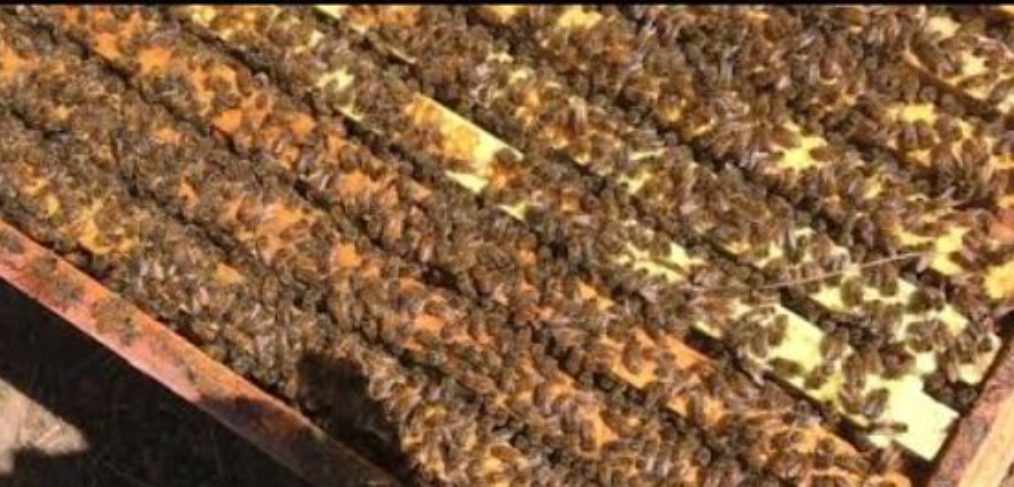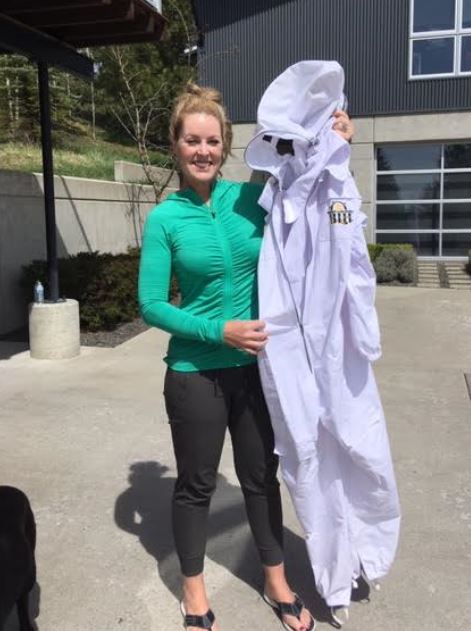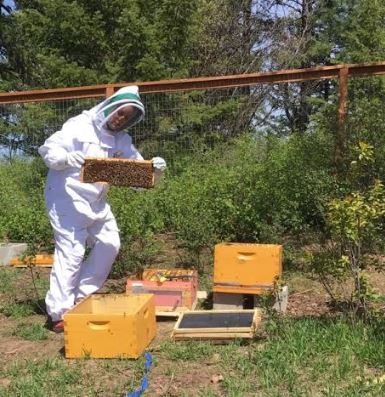
From renters to homeowners: transferring your bees
Once you have your new set of bees (either purchased on line, or better yet, from a local beekeeper), it’s time to transfer the renters from their temporary home to the permanent one. To see the entire 3.5 min video (condensing 30 min) click here.
Getting your money back: one reason to transfer
Why not leave them in the one provided by the bee keeper you ask? It might surprise you to know that most bee keepers put about $50 into their “temp bee homes,” and this is included in purchase price. So, if you don’t car about the money, it’s a non-issue, but most bee keepers want the hive back. So once transferred, you go back for your $50. Second to this is a consistent look and function. Specifically, Roger reduced the size of the front. This means the guardian bees have a smaller opening to protect from the wasps, who want to raid the hive for honey (a common issue).
Step one- don the right underclothing
I’m not into getting stung, so I wear a bee suit, and no, I don’t go commando. I wear my lightweight, Athleta gear, which is breathable, wicks, and above all, it’s made from 85% recyclable material. I could go on about doing my part for the environment, but I’d lose you at “the,” so I’ll leave it at this: I’m not going to work hard to live sustainably if I then turn around and don’t try my best to do the same with my clothes. The long sleeve, zip up top I’m wearing in high teal is this one. The pants aren’t sold on-line but you can go to your local Athleta store- the closest to me is Spokane, and your items can be ordered by phone, same price.

Step two-Zip the suit
You’d not believe how many friends (fellow bee-hivers) don’t zip all the way, missing that last, little spot on the back of your neck! Can you imagine how awful it would be to have a really pissed off bee inside your suit? It’s like that old Star Trek film where Sulu gets the worm put in his ear by Kahn. Gerrr—rose.
Step three- smoke the bees
The first year, I went smokeless. I rationalized that it would be akin to giving my bees drugs. (I was told that the bees go slightly dizzy and that just felt wrong). When the bees swarmed me, it was like a bad, B-movie, a thousand hunter bees all attacking my head. It was a good thing I’m not claustrophobic and had faith in my outfit because I was a little on the edge when this swarm attacked my face. Fortunately, I made it through 100% unscathed, but learned a lesson. There’s a reason bee keepers use smoke. This time around, I purchased a smoker, and inside, stuffed a bunch of needles and lit it up.
As you can see in the video, I had less than a dozen bees even approach me. They were preoccupied.In the year since, I learned that the bees actually think the hive is on fire, they “swarm” inside the hive, flapping their wings like mad, trying to put out the fire. This, scientists hypothesize, makes them slightly dizzy. Whatever the case, the bees were perhaps twenty-percent as crazy as last year. I only had a few land on me then buzz away. Contrast this with last year, when I literally had a probably a hundred landing on my face mask. It was downright spooky.
Step four-transferring the bees
Already in the permanent hive (set on two level, cement blocks) was a 2-gallon container full of equal parts water and sugar which I had made. This gives the bees the boost they need if the area doesn’t have enough sources of pollen. (most pre-assembled hives come with the plastic, 2-gallon container. All you need to do is make the mixture). When transferring the trays, the trick is to gently separate the trays and locate the queen. Ours came with a green dot on her back, placed by the originating bee keeper. Once you can see she’s alive and healthy, down the tray goes into the middle of the stack.

Step five- adding the pollen pack
This is another way to boost production. In our area, spring was a little late in coming this year, and our area doesn’t have a ton of sources of pollen. That’s one reason to get the bees in the first place! This pack goes on the top of the trays, then the two upper lids are replaced.
Bee back in 30 days to check the honey
Last year, we had a good amount of honey after a month. Because we started so late in the summer, we didn’t harvest it. Instead, we left it for the winter. When we checked it at the end of fall, we had approximately forty pounds. That was only from a single hive. This year, we are doubling down, so I’ll be back in thirty with a report on the yield.
If you never thought you could own bees, take heart. Neither did I, thereby once again justifying my motto: if I can do you, you can do it too!
Feature image: a top picture of 20K bees happily hovering in their new abode.
